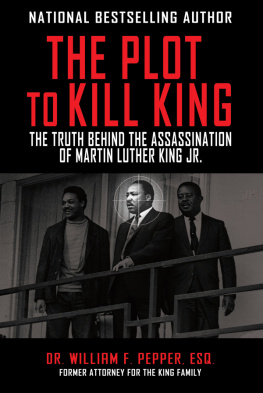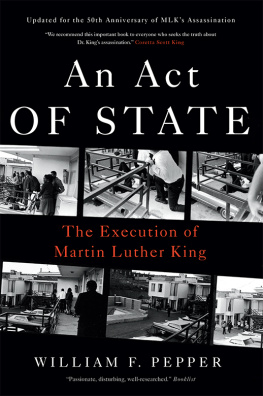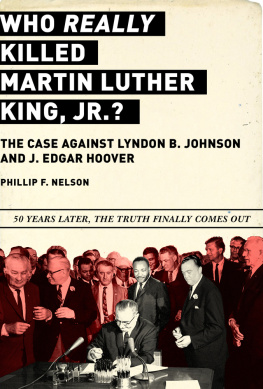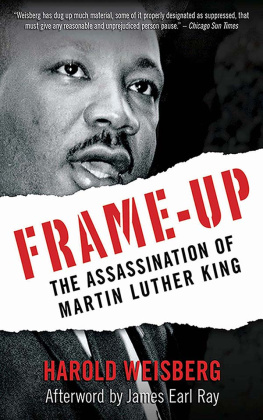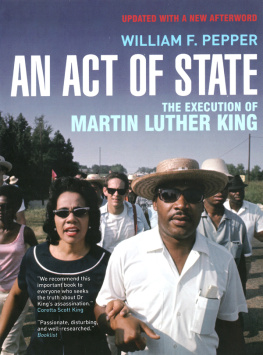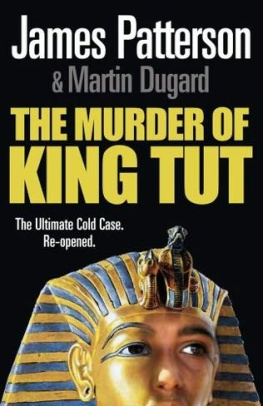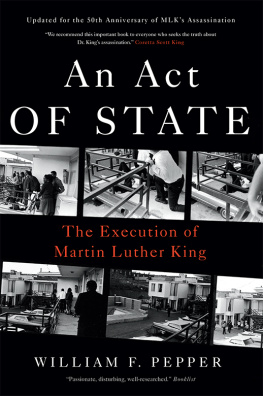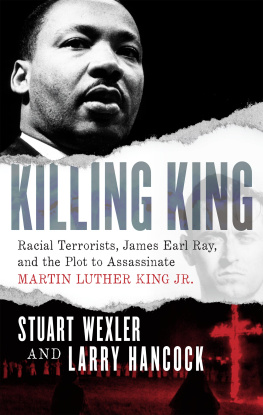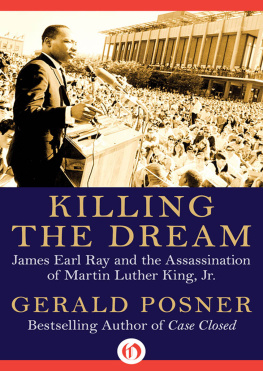Copyright 2016 by William F. Pepper
All rights reserved. No part of this book may be reproduced in any manner without the express written consent of the publisher, except in the case of brief excerpts in critical reviews or articles. All inquiries should be addressed to Skyhorse Publishing, 307 West 36th Street, 11th Floor, New York, NY 10018.
Skyhorse Publishing books may be purchased in bulk at special discounts for sales promotion, corporate gifts, fund-raising, or educational purposes. Special editions can also be created to specifications. For details, contact the Special Sales Department, Skyhorse Publishing, 307 West 36th Street, 11th Floor, New York, NY 10018 or .
Skyhorse and Skyhorse Publishing are registered trademarks of Skyhorse Publishing, Inc., a Delaware corporation.
Visit our website at www.skyhorsepublishing.com.
10 9 8 7 6 5 4 3 2 1
Library of Congress Cataloging-in-Publication Data is available on file.
Cover design by Rain Saukas
Print ISBN: 978-1-5107-0217-2
Ebook ISBN: 978-1-5107-0218-9
Printed in the United States of America
To the Legacy and eternal memory
of Dr. Martin Luther King Jr. and his family
who have long travelled the elusive road to closure and secondarily,
To the principal inspirational sources of my quest:
The publishers of Ramparts magazine, whose publication of my article
really was at the beginning of this history;
Bill Atwood, (dec.) the managing editor of Look magazine
who wanted to bring that story to the American masses, over
the objections of President Lyndon Johnson, but who was denied
that opportunity by an untimely death;
The innocent and courageous people of Vietnam,
innocent victims of American war crimes;
Pete Seeger, Ben Spock, Dan Berrigan, Bill Coffin, Flo Kennedy,
Julian Bond, Father Frank Morales, and Jim Douglas, and the countless
others who have toiled for their entire lifetimes in the cause of peace, freedom, and
justice, each one of whom provided to me essential emotional, and spiritual examples
and support in this long nonviolent struggle for the soul of the American Republic.
ACKNOWLEDGMENTS
Jean Hazel Obraywhose tireless work for more than ten years, including legal assistance, research, and superlative editing was outstanding and essential in laying the foundation for the initial breakthroughs up to 1998.
Wayne Chastain Esq. (dec.)My associate counsel in the early proceedings taken on behalf of James Earl Ray.
Brian DominskiMy long-suffering and diligent court reporter who was always ready to perform with excellence.
The First Pepper FamilyWho suffered greatly during the ordeal of the investigation and legal proceedings, even requiring removal to England for security reasons.
The Second Pepper FamilyWho have continued to experience collateral inconvenience in the final years leading up to the publication of this work.
Ron Tyler AdkinsWhose personal recollections of relevant events were invaluable in piecing together the complete conspiracy.
John McFerrinWhose courage never wavered as he revealed what he heard and learned.
Len CurtisWho demonstrated extraordinary courage as he revealed the crucial events he heard and observed on April 4, 1968.
Johnton ShelbyWhose courage and determination honored his mothers tearful account of her groundbreaking observations in the hospital where Dr. Martin Luther King Jr. died.
Mark Lane, Dick Gregory, Harold Weisberg, Phil Melanson, and Jim LesarAll of whom kept the search for truth alive in the early years following the assassination.
The Members of the InvadersWho must also be regarded as victims of Memphis racism.
JackieWhose long-suffering presence and vigil opposite the Lorraine Motel has been a source of invaluable information.
Nathan WhitlockWhose contribution of information and action have greatly added to this effort for truth.
Glenda GrabowWhose critical identity of James Earl Rays handler, Raul Coelho, demonstrated incredible courage and detailed information.
All of the witnesses who testified at the 1999 Civil Trial and fleshed out the record as we knew it at the time.
CONTENTS
PREFACE
I t has been nearly half a century since Martin Luther King Jr. was taken from us. From the outsetforty-seven years ago, as set out in detail in the epilogueone writer after another has attempted to disinform the citizens and create false history.
Like most people, I accepted the official story about how Dr. Martin Luther King Jr. was murdered. I believe this was the result of my naivet or perhaps the desire to put the loss of a friend behind me. In any case, when Dr. Benjamin Spock, the pediatrician and antiwar activist, and I traveled to Memphis for the memorial march on April 8, 1968, four days after the assassination, as far as I was concerned it was in the hands of the police.
In the following years, I heard about inconsistencies in the states case and rumors of a conspiracy in which James Earl Ray was framed for Dr. Kings murder. Then in 1977 to 1978, following a conversation with the Reverend Ralph Abernathy, and at his suggestion, I prepared for and conducted a five-hour interview with James Earl Ray. Since that time, the mystery of Dr. Kings assassination has dominated much of my life. In no small measure, I suppose, this is because of the responsibility I feel for having initially prompted him to oppose the Vietnam War. That stand was a major factor contributing to his death.
The intervening years have only strengthened my belief that Dr. Kings assassination constituted the greatest loss suffered by the Republic in the twentieth century. To understand his death, it is essential to realize that although he is popularly depicted and perceived as a civil rights leader, he was much more than that. A nonviolent revolutionary, he personified the most powerful force for the long-overdue social, political, and economic reconstruction of the nation.
Those in charge of the United States intelligence, military, and law enforcement machinery understood Dr. Kings true significance. They perceived his active opposition to the war and his organizing of the poor as grave disruptions to the stability of a society already rife with unrest. FBI Director Hoover, in particular, took the position that Dr. King was under communist control.
The last year of Dr. Kings life was during one of the most turbulent times in the history of the nation. Much of the civil unrest took the form of nationwide urban riots and was clearly the result of racial tensions, frustrations, and anger at oppressive living conditions and the endemic hopelessness of inner-city life. However, one cannot consider these explosions without taking into account the pervasive presence of the war, its legitimization of violence, and its overall impact on the neighborhoods of the country.
In the year running up to July 1967, the number of riots and other serious disruptions against public order had reached ninety-three in nineteen states. In August, an additional thirty-three riots occurred in thirty-two cities in twenty-two states.
Dr. King was at the center of it all. His unswerving opposition to the war and his commitment to bring hundreds of thousands of poor people to a Washington, DC, encampment in the spring of 1968 to focus Congresss attention on the plight of the nations poor turned the governments anxiety into utter panic. In retrospect, I believe that there was no way Dr. King was going to be allowed to lead this army of alienated poor to Washington to take up residence in the shadow of the Washington Memorial.

